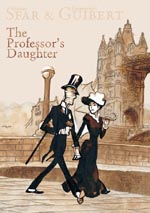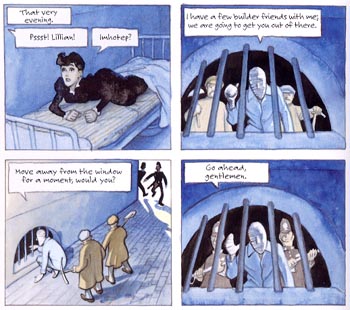 Written by Joann Sfar
Written by Joann Sfar
Art by Emmanuel Guibert
80 pages, color
Published by First Second Books
One of the great things about so many foreign language comics not yet being translated means that there’s forever a wealth of comics that may be old to its original audience, but about to become new to someone else. Joann Sfar and Emmanual Guibert’s The Professor’s Daughter is one of those books; it may be relegated to little more than a footnote in France, but in its new English-language edition it’s something to get excited about. Having seen Guibert and Sfar team up for Sardine in Outer Space already, I figured this would be another silly but fun romp. The end product, though, was something a little more peculiar and intriguing, almost determined to keep itself from being pigeon-holed in any one genre.
 Lillian lives a privileged life in Victorian Era London, part of upper society as the daughter of a renowned professor. Imhotep IV is a long deceased Pharaoh of Egypt, come back to life after many centuries to experience modern life. The two are deeply in love, but between each of their fathers and London society in general, the chances of them getting a happily ever after are looking remarkably slim—and Imhotep knows just how long “ever after” can truly be.
Lillian lives a privileged life in Victorian Era London, part of upper society as the daughter of a renowned professor. Imhotep IV is a long deceased Pharaoh of Egypt, come back to life after many centuries to experience modern life. The two are deeply in love, but between each of their fathers and London society in general, the chances of them getting a happily ever after are looking remarkably slim—and Imhotep knows just how long “ever after” can truly be.
If I had to sum up The Professor’s Daughter in one word, it would probably be “unpredictable.” After an initial set-up in which you think you know exactly what’s going on (a charming mismatched romance), Sfar’s script seems to delight in surprising the reader. Each twist and turn seems to come out of nowhere, with additional mummies, kidnappings, murder, court cases, and even Queen Victoria herself showing up out of nowhere. It’s a rambling sort of story, feeling almost like it was written several pages at a time with no real destination in mind and letting the characters dictate each surprise. Its unpredictability works in smart because of its shorter length; in a longer work the constant side-trips and shifts might get irritating, but here it’s fun because it’s almost like a concentration of madness that erupts in one quick burst.
 I hadn’t seem Guibert’s art before, making me somehow assume that he and Sfar had the same art style since the two have collaborated on projects in the past. In fact, Guibert’s creations look completely different, but in a good way. Guibert’s art here is a series of graceful watercolors, each page six delicate paintings. Guibert composes each page as a single unit, often using a limited color palette to help link the six panels together. While the sepia-based pages help bring across the idea to the reader that this is set in an earlier time, it’s his vivid blues and greens that really grabbed my attention the most as page-builders, almost leaping off the page and assaulting the eye to pay attention. As the book progresses, you can also see Guibert grow as an artist; the early pages of The Professor’s Daughter has Lillian with remarkably few facial expressions (if I saw her surprised face with the little “o” of a mouth one more time I was ready to scream) but by the end of the book she and the rest of the cast look much more nuanced and complex. It’s amazing to see an artist who is already good improve so much over the space of 60-odd pages, and more than a little gratifying to remember that some artists are forever honing their craft.
I hadn’t seem Guibert’s art before, making me somehow assume that he and Sfar had the same art style since the two have collaborated on projects in the past. In fact, Guibert’s creations look completely different, but in a good way. Guibert’s art here is a series of graceful watercolors, each page six delicate paintings. Guibert composes each page as a single unit, often using a limited color palette to help link the six panels together. While the sepia-based pages help bring across the idea to the reader that this is set in an earlier time, it’s his vivid blues and greens that really grabbed my attention the most as page-builders, almost leaping off the page and assaulting the eye to pay attention. As the book progresses, you can also see Guibert grow as an artist; the early pages of The Professor’s Daughter has Lillian with remarkably few facial expressions (if I saw her surprised face with the little “o” of a mouth one more time I was ready to scream) but by the end of the book she and the rest of the cast look much more nuanced and complex. It’s amazing to see an artist who is already good improve so much over the space of 60-odd pages, and more than a little gratifying to remember that some artists are forever honing their craft.
The Professor’s Daughter may be strange and unpredictable, but I really like the end result. The back cover copy mentions that this book was Sfar and Guibert’s break-out success story, and I can believe it. It may never be what you expect, but the one constant here is quality. Another worthy addition to a comic lover’s library, I continue to look forward to seeing more Sfar and Guibert books translated into English that feel “new” to me.
Purchase Links: Amazon.com
